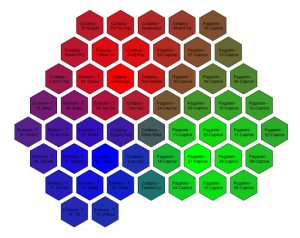Apologies for the lengthy quote but Roger makes a great case for interactive textbooks, IPython notebooks, writing for the reader as opposed to making the author feel clever, and finally, making content freely available.
It is a quote that I am going to make a point to read on a regular basis.
…
This is a book for programmers that have a need or interest in Kalman filtering. The motivation for this book came out of my desire for a gentle introduction to Kalman filtering. I’m a software engineer that spent almost two decades in the avionics field, and so I have always been ‘bumping elbows’ with the Kalman filter, but never implemented one myself. They always has a fearsome reputation for difficulty, and I did not have the requisite education. Everyone I met that did implement them had multiple graduate courses on the topic and extensive industrial experience with them. As I moved into solving tracking problems with computer vision the need to implement them myself became urgent. There are classic textbooks in the field, such as Grewal and Andrew’s excellent Kalman Filtering. But sitting down and trying to read many of these books is a dismal and trying experience if you do not have the background. Typically the first few chapters fly through several years of undergraduate math, blithely referring you to textbooks on, for example, Itō calculus, and presenting an entire semester’s worth of statistics in a few brief paragraphs. These books are good textbooks for an upper undergraduate course, and an invaluable reference to researchers and professionals, but the going is truly difficult for the more casual reader. Symbology is introduced without explanation, different texts use different words and variables names for the same concept, and the books are almost devoid of examples or worked problems. I often found myself able to parse the words and comprehend the mathematics of a definition, but had no idea as to what real world phenomena these words and math were attempting to describe. “But what does that mean?” was my repeated thought.
However, as I began to finally understand the Kalman filter I realized the underlying concepts are quite straightforward. A few simple probability rules, some intuition about how we integrate disparate knowledge to explain events in our everyday life and the core concepts of the Kalman filter are accessible. Kalman filters have a reputation for difficulty, but shorn of much of the formal terminology the beauty of the subject and of their math became clear to me, and I fell in love with the topic.
As I began to understand the math and theory more difficulties itself. A book or paper’s author makes some statement of fact and presents a graph as proof. Unfortunately, why the statement is true is not clear to me, nor is the method by which you might make that plot obvious. Or maybe I wonder “is this true if R=0?” Or the author provides pseudocode – at such a high level that the implementation is not obvious. Some books offer Matlab code, but I do not have a license to that expensive package. Finally, many books end each chapter with many useful exercises. Exercises which you need to understand if you want to implement Kalman filters for yourself, but exercises with no answers. If you are using the book in a classroom, perhaps this is okay, but it is terrible for the independent reader. I loathe that an author withholds information from me, presumably to avoid ‘cheating’ by the student in the classroom.
None of this necessary, from my point of view. Certainly if you are designing a Kalman filter for a aircraft or missile you must thoroughly master of all of the mathematics and topics in a typical Kalman filter textbook. I just want to track an image on a screen, or write some code for my Arduino project. I want to know how the plots in the book are made, and chose different parameters than the author chose. I want to run simulations. I want to inject more noise in the signal and see how a filter performs. There are thousands of opportunities for using Kalman filters in everyday code, and yet this fairly straightforward topic is the provenance of rocket scientists and academics.
I wrote this book to address all of those needs. This is not the book for you if you program avionics for Boeing or design radars for Raytheon. Go get a degree at Georgia Tech, UW, or the like, because you’ll need it. This book is for the hobbyist, the curious, and the working engineer that needs to filter or smooth data.
This book is interactive. While you can read it online as static content, I urge you to use it as intended. It is written using IPython Notebook, which allows me to combine text, python, and python output in one place. Every plot, every piece of data in this book is generated from Python that is available to you right inside the notebook. Want to double the value of a parameter? Click on the Python cell, change the parameter’s value, and click ‘Run’. A new plot or printed output will appear in the book.
This book has exercises, but it also has the answers. I trust you. If you just need an answer, go ahead and read the answer. If you want to internalize this knowledge, try to implement the exercise before you read the answer.
This book has supporting libraries for computing statistics, plotting various things related to filters, and for the various filters that we cover. This does require a strong caveat; most of the code is written for didactic purposes. It is rare that I chose the most efficient solution (which often obscures the intent of the code), and in the first parts of the book I did not concern myself with numerical stability. This is important to understand – Kalman filters in aircraft are carefully designed and implemented to be numerically stable; the naive implementation is not stable in many cases. If you are serious about Kalman filters this book will not be the last book you need. My intention is to introduce you to the concepts and mathematics, and to get you to the point where the textbooks are approachable.
Finally, this book is free. The cost for the books required to learn Kalman filtering is somewhat prohibitive even for a Silicon Valley engineer like myself; I cannot believe the are within the reach of someone in a depressed economy, or a financially struggling student. I have gained so much from free software like Python, and free books like those from Allen B. Downey here [1]. It’s time to repay that. So, the book is free, it is hosted on free servers, and it uses only free and open software such as IPython and mathjax to create the book.
…

